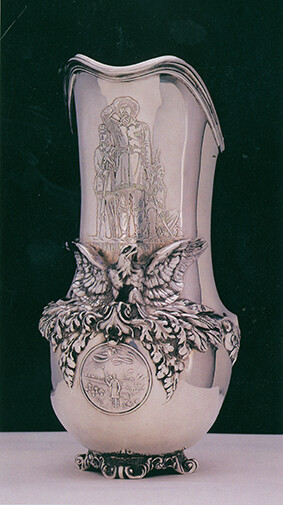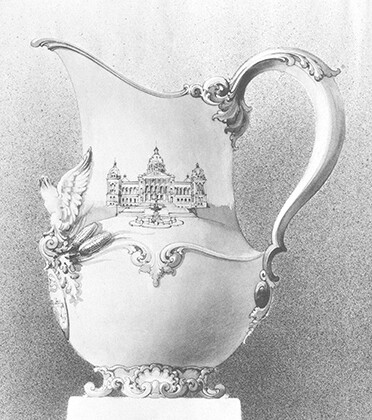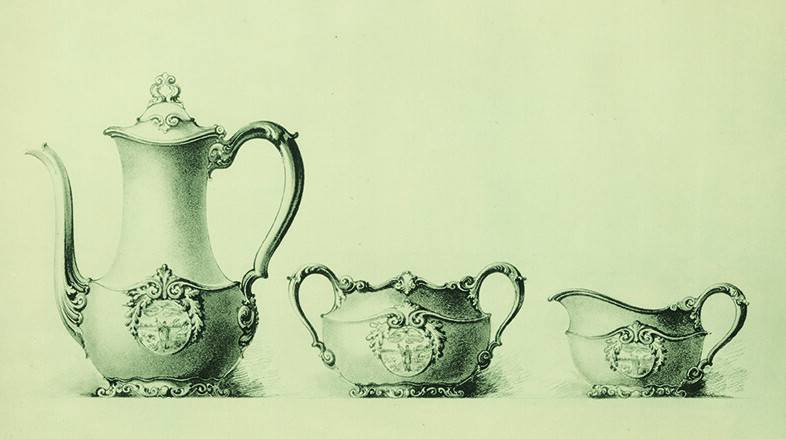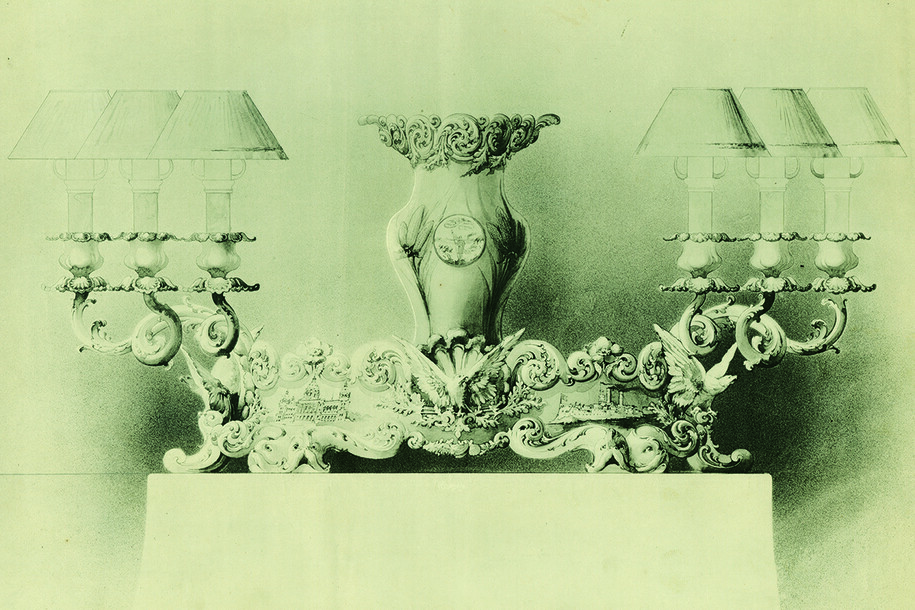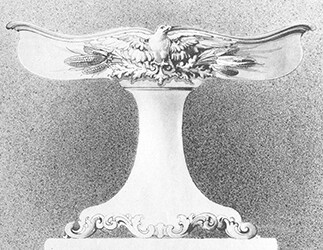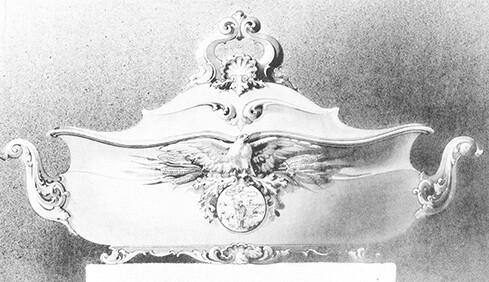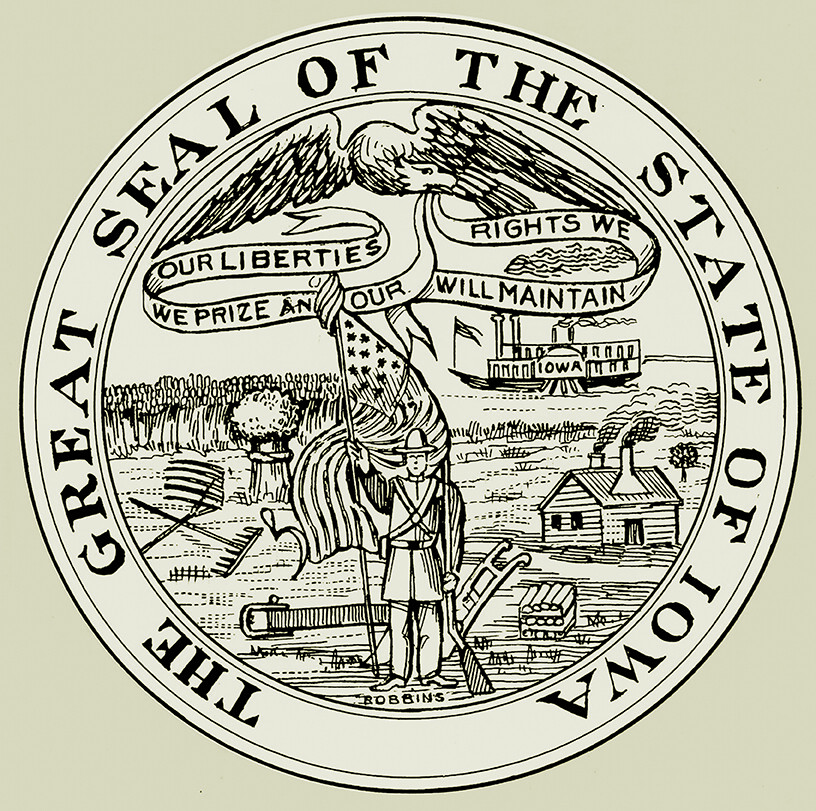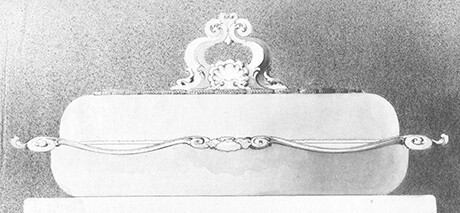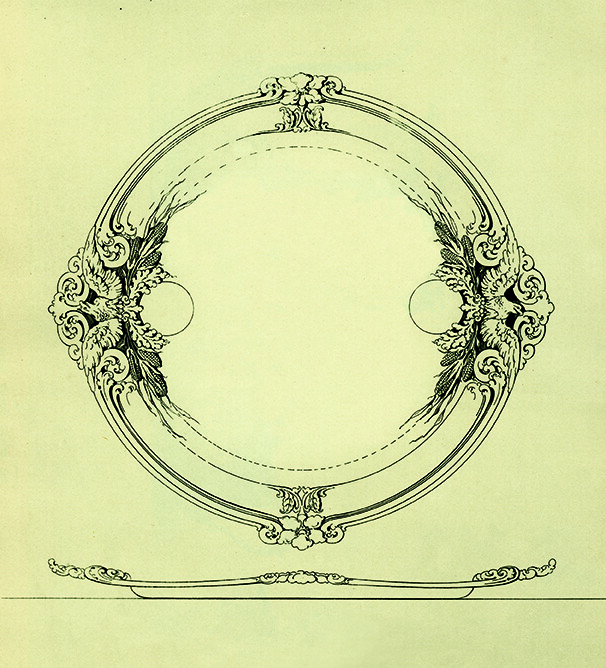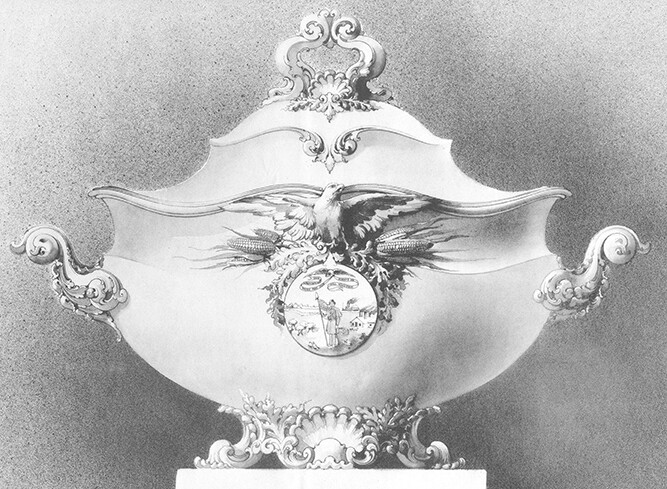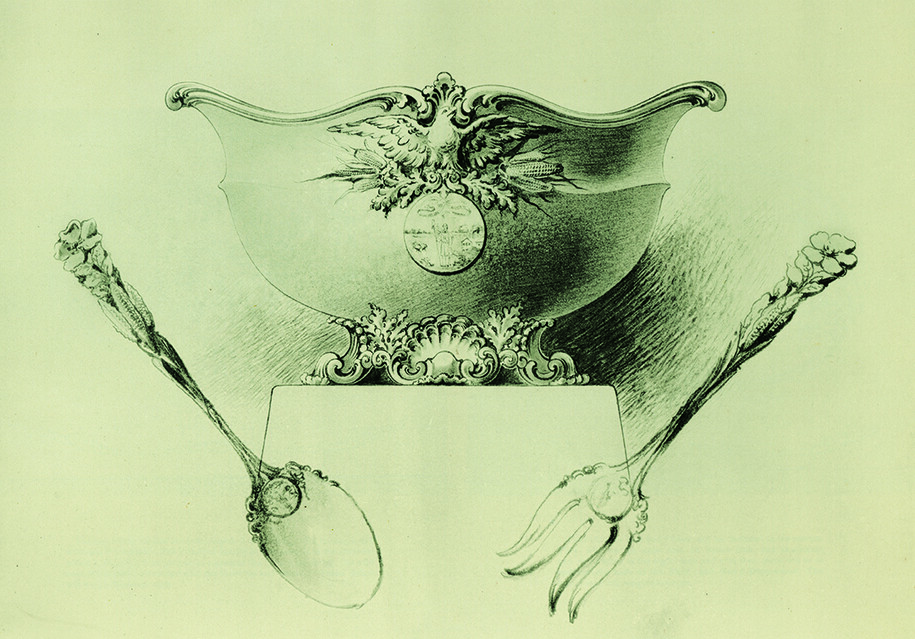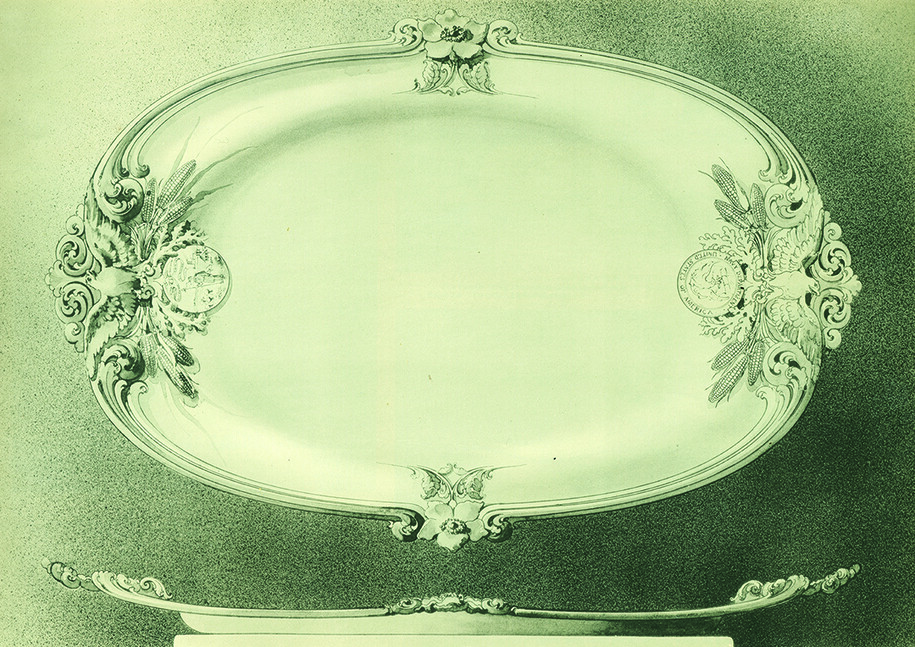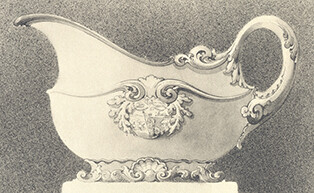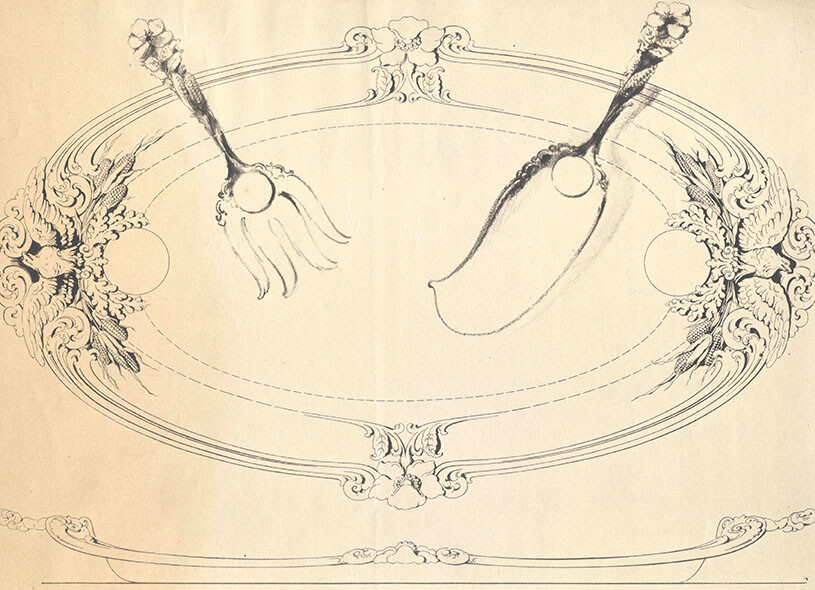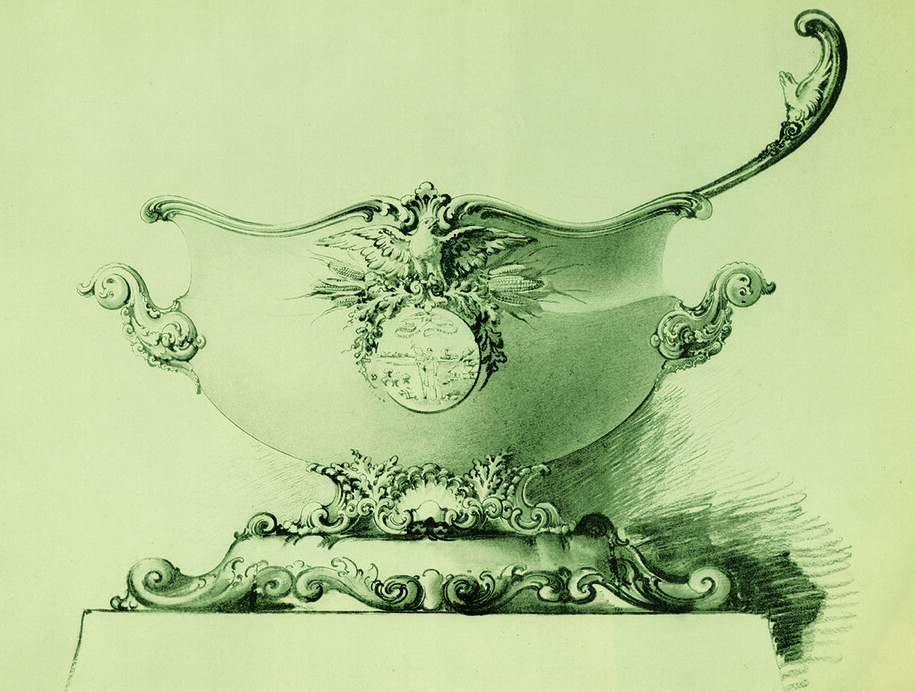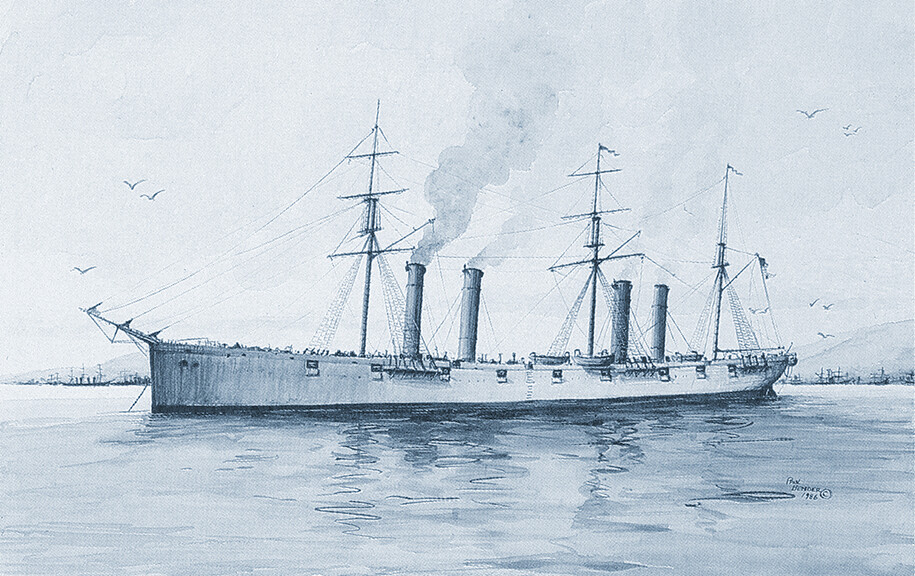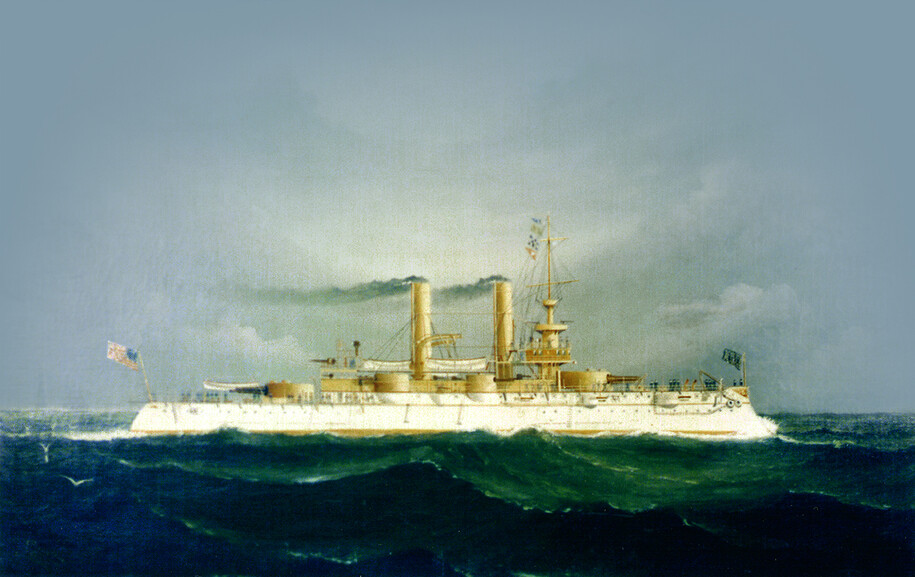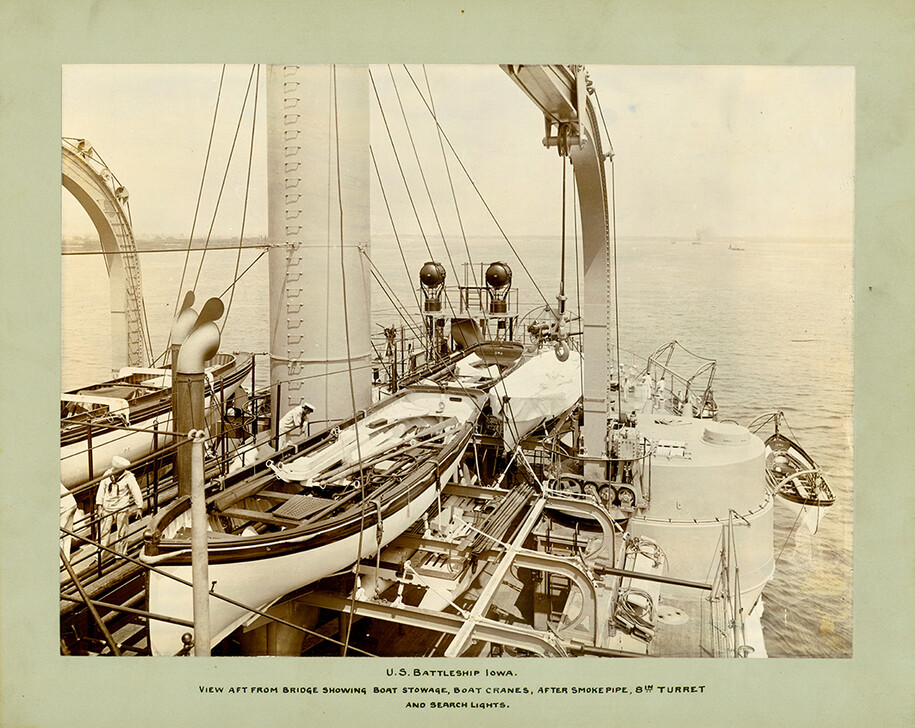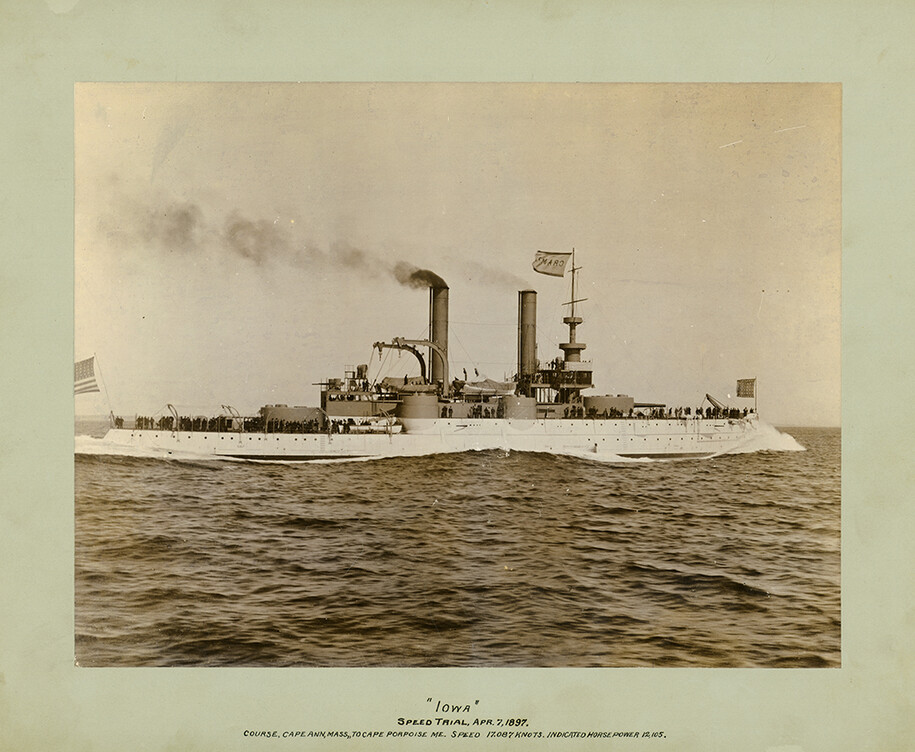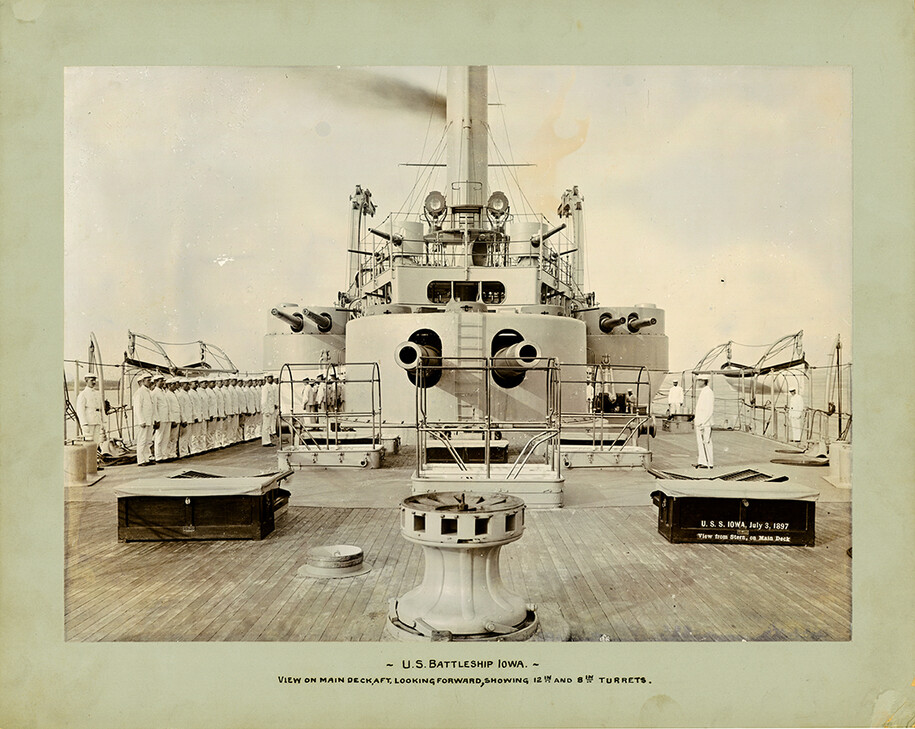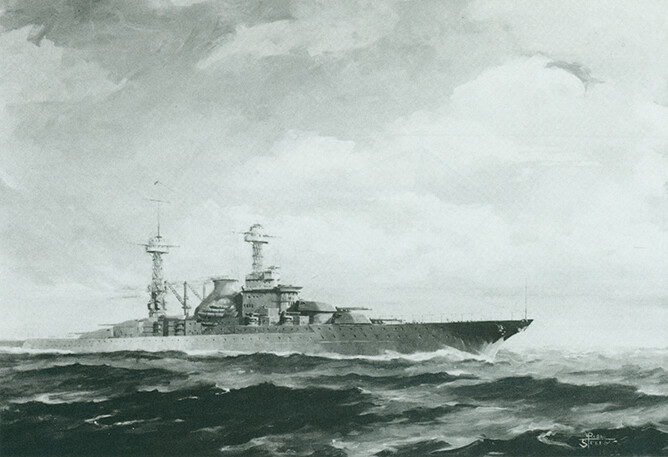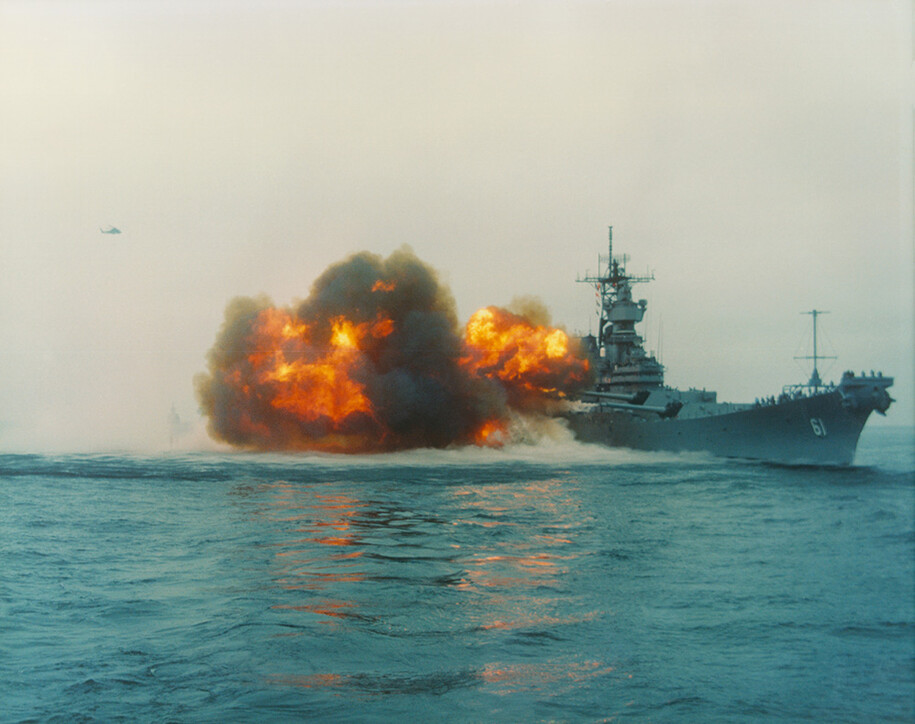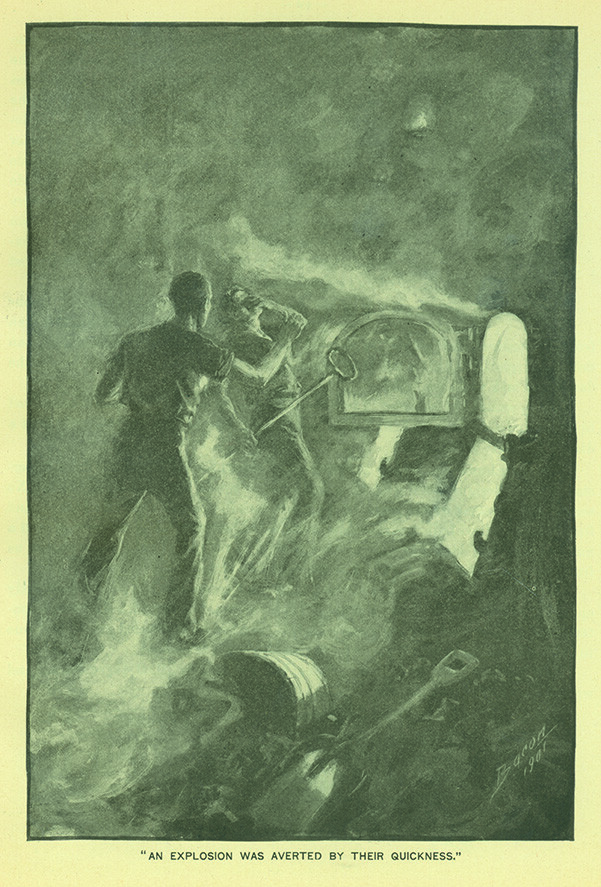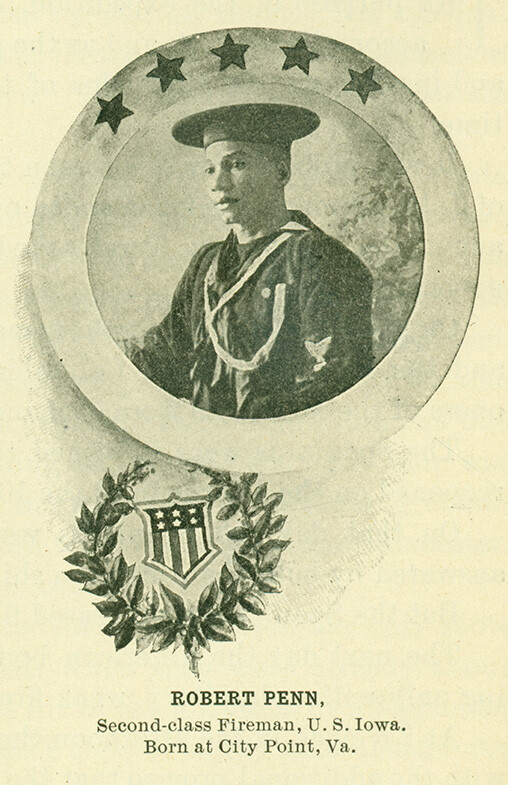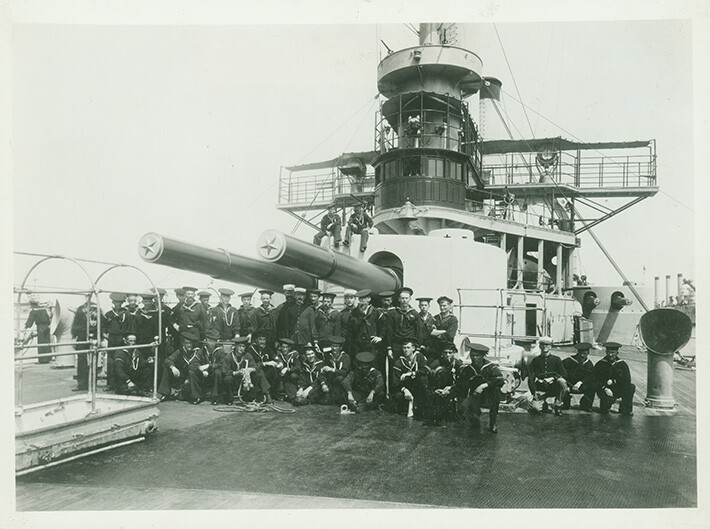On this page...
Exhibit text from the State Historical Museum of Iowa is posted online to be more accessible to people who cannot fully access in-person exhibits. If you would like to share suggestions on how to make the format of this exhibit text more accessible, please email shsi.accessibility@iowa.gov.
Back to topSection 1: Silver Service
A Service of Silver: Tribute to the USS Iowa
In 1896 Iowa celebrated 50 years of statehood and the nation honored the state by naming its first sea-going battleship the USS Iowa. The 26th General Assembly responded by authorizing the Executive Council to “provide a proper recognition of the battleship USS Iowa” and appropriated $5,000. The firm of J.E. Caldwell and Co. in Philadelphia was contracted to provide a 40-piece silver service.
High resolution image of the first USS Iowa battleship
USS Iowa Silver Service
The silver has served on the USS Iowa BB4 (1897-1923), the USS Iowa BB61 (1947-1949; 1953-1958; and 1984-1990), and on the cruiser USS Des Moines CA 134 (1948-1953). During the period 1990-1992, the silver service was placed on the aircraft carrier USS Abraham Lincoln.
The silver service was contracted to contain over 2,100 troy ounces of sterling silver, about 145 pounds.
“Illustrations of The Silver Dinner Service presented to The United States Battle-ship Iowa by The State of Iowa,” James E. Caldwell & Company, Philadelphia, Pennsylvania, 1896.
Water Pitcher
In the final design of the water pitcher, an etching of the “Pioneer” statue, from the west steps of the Capitol, replaced a view of the Capitol.
The “Pioneer” statuary was designed by Karl Gerhardt in 1892.
Contract weight: 4¼ pounds.
High resolution photograph of the water pitcher
High resolution image of the water pitcher design
After Dinner Coffee Set 1
Each of the three pieces of the coffee set bears the Great Seal of the State of Iowa.
Contract weight: 4¼ pounds.
High resolution image of the after dinner coffee set
After Dinner Coffee Set 2
Each of the three pieces of the coffee set bears the Great Seal of the State of Iowa.
Contact weight: 4¼ pounds.
Bread and Entrée Dishes
The bread and entrée dishes carry a similar design of wild roses and eagles with spread wings holding ears of corn. The seals of Iowa and the Navy Department appear beneath the eagles.
Contract weight: 3⅓ pounds.
High resolution image of the bread tray and entrée dish
Bon-Bon or Olive Trays
The four small bon-bon or olive trays continue the eagle and rose motif of the larger bread dishes including the seals of Iowa and the Navy Department.
Contract weight: 1¼ pounds.
Centerpiece
The centerpiece dominates the silver service with its size and design. Weighing nearly 30 pounds, it is composed of three parts: a flower vase, candelabra, and a shallow fruit bowl. The vase is framed in ears of corn with a central medallion of the Great Seal of the State of Iowa. The reverse side is inscribed: “Presented to the Battle-ship Iowa by the State of Iowa, July 19th, 1897.”
The removable candelabra holds celluloid candles and is topped with red cloth shades protected by isinglass and overlaid with silver filigree.
The bowl is decorated with dolphins, eagles, and etchings of the State Capitol, the USS Iowa, early Fort Madison, and a pioneer wagon.
High resolution image of the centerpiece
Comports
The eagle and corn motif dominates the four comports.
Contract weight: 1¾ pounds.
High resolution image of a comport
Single Vegetable Dish
The single vegetable dish with cover continues the eagle and seal motif.
Contract weight: 5 pounds.
High resolution image of a single vegetable dish
High resolution image of The Great Seal of the State of Iowa
Double Vegetable Dish
The double vegetable dish with cover is the least decorated piece in the service.
Contract weight: 3½ pounds.
High resolution image of a double vegetable dish
Salver
The 13-inch round waiter carries the standard service motif: eagles, roses, and the seals of Iowa and the Navy Department.
Contract weight: 2¾ pounds.
High resolution image of the salver
Butter Dishes
The two butter dishes are smaller and deeper than the bon-bon trays but carry a similar design.
Soup Tureen
On the large soup tureen a bald eagle spreads its wings above ears of corn and over the Great Seal of the State of Iowa. Large scallop shells combine to provide a base.
Contract weight: 9 pounds.
Salad Bowl with Spoon and Fork
Although slightly smaller, the salad bowl is similar to the soup tureen in form and style.
The servers display Iowa’s seal, corn, and the wild rose.
Contract weight: 8 pounds.
High resolution image of the salad bowl, spoon and fork
Meat Dish and Gravy Boats
The large meat tray is embellished with bald eagles, corn, wild roses, the Great Seal of Iowa, and the Navy Department seal.
It is inscribed: “Iowa, her affections like the rivers of her borders, flow to an inseparable union.” The inscription is attributed to Enoch W. Eastman.
Gravy boats bear the Great Seal of the State of Iowa.
Meat Dish Contract weight: 5 pounds.
Gravy Boat Contract weight: 1⅓ pounds.
High resolution image of the meat dish
High resolution image of the gravy boat
Fish Dish with Knife and Fork
The fish dish follows the motif of the meat dish with the addition of a serving knife and fork in wild rose and corn motif.
It is inscribed: “In all that’s good, Iowa affords the best.” The inscription is attributed to Sidney A. Foster.
Contract weight: 5½ pounds.
High resolution image of the fish dish, knife and fork
Punch Bowl Set
The three-piece punch bowl set continues the eagle and seal motif of the other major bowls, with the addition of a ladle topped by an eagle. The base is separate.
Contract weight: 20 pounds.
High resolution image of the punch bowl set
Back to topSection 2: The Ships Named “Iowa”
A Service of Silver: Iowa’s Impact at Sea
The name “Iowa” has a significant history with the United States Navy. Notably the Iowa Battleship Number 4 (BB4), which entered service on June 16, 1897, was the Navy’s first ever sea-going battleship. On the BB4, eight men received Medals of Honor for heroism during boiler accidents in 1898 and 1905.
The USS Iowa BB61 also made significant contributions during war. The ship carried President Franklin D. Roosevelt to the Tehran Conference in 1943 and it was present in Tokyo Bay when the Second World War ended with Japan’s formal surrender on September 2, 1945.
A large collection of silver remains from Iowa’s time at sea. Once a widespread custom, the BB4 was presented with a 40-piece silver service — a collection of food and beverage serving vessels used for official ceremonies on the ship. The silver in this exhibit is on long-term loan from the U.S. Navy.
The Ships Named “IOWA”
USS IOWA, 1869-1883
Designed by Benjamin Franklin Delano, this frigate warship was built from 1863 to 1864 at the Boston Navy Shipyards. Its engines were installed in New York in 1867. The cost was $1,261,250, which is equivalent to roughly $30,541,000 in 2023.
Originally designed as a fast commerce raider, the ship carried an armament of 10 smoothbores nine inches in diameter, three 60-pounder rifles, and two 24-pounder smoothbores.
Nearing completion about nine months before the Civil War’s end, the ship never saw service. In the 1868 time trials, the ship sustained speeds over 17 knots (19.5 mph) and at that time was the fastest ship in the United States Navy.
With no war to fight or other relevant mission, the ship returned to the Boston Navy Shipyards in 1868, where the name was changed from the USS Ammonoosuc to the USS Iowa in May 1869. It was sold in 1883.
Did you know?
“Ammonoosuc,” the original name of the USS Iowa until 1869, means a “stony place for fishing” in the Abenaki language. The Abenaki peoples are native to the Northeastern Woodlands of North America and fished along the Ammonoosuc River in northern New Hampshire.
High resolution image of the first USS Iowa
USS IOWA BB4, 1897-1923
Congress authorized the construction of the USS Iowa BB4 in 1892. The ship was built by William Cramp & Sons in Philadelphia, Pennsylvania and it was launched on March 28, 1896. Mary Lora Drake, daughter of Iowa’s governor Francis M. Drake, christened the ship on June 16, 1897.
The ship reportedly carried 512 men and could sustain a speed of 17 knots (19.5 mph). Armament consisted of four 12-inch rifles, eight 8-inch rifles, and numerous smaller guns. In 1892 the ship cost $3,110,000, which is equivalent to roughly $107,626,000 in 2023.
During the Spanish-American War, the USS Iowa assisted in the destruction of the Spanish fleet at Santiago de Cuba. In this instance, the Iowa’s crew proved to be both effective in battle and compassionate in the rescue of Spanish sailors and officers from their stricken vessels.
As the First World War approached, larger and more powerful ships soon overshadowed the USS Iowa and it became outdated. With the outbreak of war, the ship was relegated to training and coastal defense. In 1923 the USS Iowa sank while serving as a radio-controlled target vessel.
High resolution image of the USS Iowa BB4
This shipbuilder’s model of the USS Iowa was made in 1902 at the William Cramp & Sons Shipyard at a cost of $2,500.
High resolution photograph of USS Iowa from the bridge
High resolution photograph of the USS Iowa 1897 speed trial
High resolution photograph of the USS Iowa BB4’s main deck
Did you know?
From 1888 to 1947, the U.S. Navy built 59 battleships. The Navy planned 20 more ships, but never finished them. The USS Iowa BB4 was the first battleship bearing the name “Iowa” and was assigned a “BB” series number when hull numbers were created in 1920. Other common classifications are “DD” for destroyer, “CA” for cruiser, and “CV” for aircraft carrier.
USS IOWA BB53, 1920-1923
Construction of the USS Iowa BB53 began by the Virginia-based News Shipbuilding & Drydock Company in 1920, but with over 30 percent of the BB53 completed, the Navy halted the project in 1923. In accordance with the Washington Naval Treaty of 1922, the Navy scrapped the Iowa BB53 and five other South Dakota class ships.
The ship was designed to carry an armament of twelve 16-inch guns, three in each of four turrets, sixteen 6-inch guns, eight on each side of the ship, and to reach a speed of 23 knots (26.5 mph).
High resolution image of the USS Iowa BB53
USS IOWA BB61, 1943-1990
The USS Iowa BB61 was the last ship to bear the name “Iowa.” It inaugurated a new class of battleships called the “Iowa-class,” less heavily armored and with fewer guns, but with greater shooting accuracy. The ship could reach speeds of up to 33 knots (38 mph). The main armament consisted of nine 16-inch guns and numerous smaller caliber weapons. In the Second World War, it carried 2,637 enlisted men and 151 officers.
The USS Iowa BB61 was completed at the New York Shipyards and christened by Ilo Browne Wallace, wife of Vice-President Henry A. Wallace, both Iowa natives. The ship entered service in 1943. The cost was $110,000,000, which is equivalent to roughly $1.94 billion in 2023.
During the Second World War, the BB61 carried President Franklin D. Roosevelt to the Tehran Conference in Iran where he discussed military strategy with British Prime Minister Winston Churchill and Soviet Premier Joseph Stalin. Upon its return, the BB61 moved to the Pacific Theater and supported many of the operations leading to the final surrender of Japan.
After a short period in the “mothball fleet,” a group of reserved ships ready for battle, the Iowa supported United Nations forces during the Korean Conflict. In this role the ship fired twice the number of 16-inch shells as it had during the Second World War.
The ship was decommissioned by the Navy in 1958, only to be recalled and refitted in 1982 with Harpoon and Tomahawk missiles. In 1989 the ship added an additional 16 Harpoon and 32 Tomahawk missiles at a cost of $385 million. On April 19,1989, an explosion in one of the 16-inch turrets killed 47 crewmen. The ship was still deployed to Europe and the Mediterranean Sea until it was decommissioned in October 1990.
High resolution photograph of the USS Iowa BB61 firing guns
Online Tour of the USS Iowa BB61
Today the USS Iowa BB61 is berthed at Los Angeles, California, at the Battleship USS Iowa Museum. The ship is open to the public both in-person and online. Explore an immersive online tour of the USS Iowa BB61.
Additional Images of the USS Iowa Ships Online
More historic photographs of the USS Iowa BB4, BB53 and BB61 can be viewed on the Naval History and Heritage Command website.
Back to topSection 3: USS Iowa Medal of Honor Recipients
USS Iowa Medal of Honor Recipients
The Navy’s Medal of Honor
The Navy and Marine Corps Medal of Honor is the oldest and highest military decoration in the United States. Secretary of the Navy Gideon Welles created the honor on December 16, 1861. Only enlisted men were eligible for the award until naval officers became eligible in 1915.
The design and award criteria for the medal have changed since it was created. Today the medal is awarded for acts of bravery and heroism at the risk of life, above and beyond the call of duty.
In the late 19th century, crews of steam-powered warships had to be prepared for boiler explosions and high pressure steam leaks from broken gaskets. On two occasions, the Iowa’s safety was threatened by boiler accidents. In both instances, the vessel was saved by the action of a few crew members. Their bravery was recognized with Medals of Honor.
High resolution image of the Medal of Honor
July 20, 1898
On July 20, 1898, a boiler gasket in the fire room burst on the USS Iowa BB4. The weakened boiler soon filled the room with boiling water and steam. Fearing an explosion, Robert Penn and Philip B. Keefer rushed into the room, saved an injured seaman, and extinguished the boiler fires. For their daring actions, they each received the Medal of Honor.
High resolution image of the 1898 boiler fire
Coppersmith Philip B. Keefer
Medal of Honor Citation: On board the USS Iowa off Santiago de Cuba, 20 July 1898. Following the blow-out of a manhole gasket of that vessel which caused the fire room to be filled with live steam and the floor plates to be covered with boiling water, Keefer showed courageous and zealous conduct in hauling fires from two furnaces of boiler B.
Fireman 1st Class Robert Penn
Medal of Honor Citation: On board the USS Iowa off Santiago de Cuba, 20 July 1898. Performing his duty at the risk of serious scalding at the time of the blowing out of the manhole gasket on board the vessel, Penn hauled the fire while standing on a board thrown across a coal bucket one foot above the boiling water which was still blowing from the boiler.
Did you know?
Robert Penn was one of only six African Americans to receive the Medal of Honor during the Spanish-American War and is the last African American sailor to have been awarded the medal for bravery during combat.
High resolution image of Robert Penn
January 25, 1905
On January 25, 1905, the following men were each awarded a Medal of Honor for displaying extraordinary heroism following the blowing out of the manhole plate of boiler D of the USS Iowa BB4.
- Fireman 1st Class Frederick Behne
- Seaman 1st Class Heinrich Behnke
- Watertender Patrick Bresnahan
- Fireman 1st Class Demetri Corahorgi
- Boilermaker Edward Floyd
- Chief Watertender Johannes J. Johannessen
High resolution photograph of the USS Iowa crewmen around 1898
Back to top
